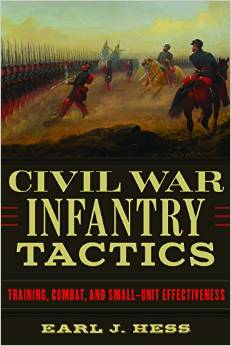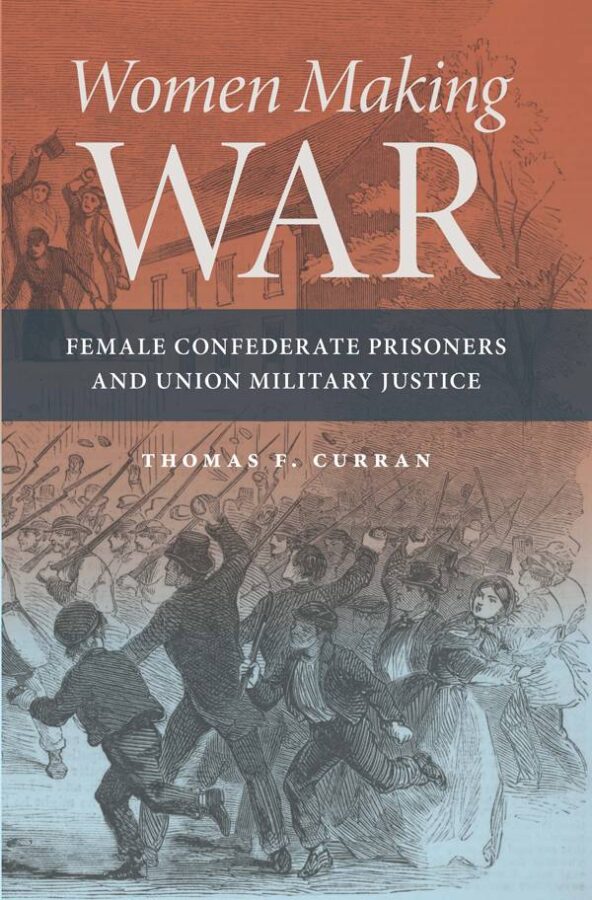Civil War Infantry Tactics: Training, Combat, and Small-Unit Effectiveness by Earl J. Hess. Louisiana State University Press, 2015. Cloth, ISBN 978-0807159378. $45.00.
 Of all the Union generals of the Civil War, none surpassed Andrew A. Humphreys’ reputation as a hidebound martinet, a man so obsessed with military pedantry that one of his subordinate officers published an 1864 expose on how Humphreys represented all that was narrow-minded about the Union war effort. The sensationalist account (whose “anonymous” author is identified by Frederick Arner as Col. William H. Armstrong, 129th Pennsylvania) relates how Humphreys upbraided a lieutenant in late 1862 for not knowing his business in company drill, and then the general insisted on bringing his prey before a board of examination to prove (or, as Humphreys would have it, disprove) the lieutenant’s competence. “In the course of it,” Armstrong wrote, “the Lieutenant said that ‘he’d be d—d if he came into the army to study tactics; he came to fight.'” [1]
Of all the Union generals of the Civil War, none surpassed Andrew A. Humphreys’ reputation as a hidebound martinet, a man so obsessed with military pedantry that one of his subordinate officers published an 1864 expose on how Humphreys represented all that was narrow-minded about the Union war effort. The sensationalist account (whose “anonymous” author is identified by Frederick Arner as Col. William H. Armstrong, 129th Pennsylvania) relates how Humphreys upbraided a lieutenant in late 1862 for not knowing his business in company drill, and then the general insisted on bringing his prey before a board of examination to prove (or, as Humphreys would have it, disprove) the lieutenant’s competence. “In the course of it,” Armstrong wrote, “the Lieutenant said that ‘he’d be d—d if he came into the army to study tactics; he came to fight.'” [1]
But fighting without training was suicide, and in Earl Hess’s landmark new treatment we come to understand how professionals like Humphreys, alongside countless amateur officers, cultivated “the best training yet to be seen in America’s military history, applied to a far larger mass of armed men than ever before in North America” (61). Hess rewards readers with a thorough discussion of Civil War tactics expertly contextualized within the wider western experience. He adds to topics such as the rise of specialized skirmish techniques, a hallmark of French Revolutionary armies described by John Lynn (Hess notes on page 102 that, “In fact, the Civil War saw the best examples of effective skirmishing in Western military history,” a fair statement that could nonetheless raise the ire of some who glorify Napoleon’s tirailleur or Wellington’s 95th Rifles). Those interested in Civil War tactical formations will find in Hess’ book not only what a “right-wheel” movement was, but what its roots were in early modern Europe and how Union and Confederate officers new to uniform instilled its execution into volunteer regiments. All the major considerations in battlefield tactics are here—rates of advance, oblique movements, passage of lines, and many others.
Most of Hess’s sources come from a laudable saturation-reading of the Official Records of the War of the Rebellion, and a majority of those come from the Western Theater, which is always a welcome change in Civil War military history. But his study maintains a broad enough view that he effectively contrasts the West from the Virginia Theater at several points. He credits George B. McClellan, for instance, with instituting army-wide drill operations in early 1862 that left Don Carlos Buell’s Army of the Ohio “three months behind” in tactical capabilities (64).
The most important contribution Hess makes in Civil War Infantry Tactics is his chapter on training, that all-important period between enlistment, with its dramatic rage militaire, and a regiment’s first engagement, which holds a drama all its own. The literature on Civil War training remains remarkably scant, despite copious accounts in soldiers’ letters and diaries of “sham battles” and the annoying redundancies of drill. For those interested in the institutional history of the United States Army and how it turns recruits into soldiers capable of the sort of slaughter that the Civil War produced, Hess’ volume will remain a bookshelf staple for years to come.
Additional areas remain available for investigation, including the connections between tactical training and manpower policy in the war. Hess notes that in late 1864, Union Fifth Corps commander Gouverneur Warren instituted review boards like Humphreys’ to motivate “refresher courses” in tactical articulation. But these were necessary because of the unprecedented losses of the Overland and Petersburg Campaigns, coupled with the army’s constant reenlistment problems from late 1863 to mid-1864. Collectively, they had drained the Army of the Potomac of its pool of trained soldiers which, consequently, hampered its institutional memory and combat effectiveness. Also worth a closer glance is how white soldiers who earned new shoulder straps tackled the problems of small-unit command as line officers in the United States Colored Troops.
Civil War Infantry Tactics builds on a critical mass of literature and yet still manages to transcend it. Paddy Griffith broke interpretive ground with Battle Tactics of the Civil War, which first exposed the rampant assumptions about rifle muskets that had injured Civil War literature for decades (a battle flag picked up successively by Mark Grimsley, Brent Nosworthy, and to greatest effect by Hess himself). But an undercurrent in Griffith’s work is that the Civil War was a Napoleonic conflict poorly waged by foolish amateurs who should have known their deadly craft better. In contrast, Hess shows us that many Civil War officers were neither Armstrong’s martinets nor Griffith’s simpletons. They were amateurs, yes, but critical-thinking amateurs who tackled the available literature on their subject with exactly the sort of voracious enthusiasm one might expect from an American volunteer with a chip on his shoulder.
Few Civil War historians have ever given us such insightful analysis of Civil War combat as Hess consistently does. Standing on a Civil War battlefield today, it is often difficult to imagine what the frenzy looked like as skirmish lines bounded over fences, brigades advanced over cornfields and fell apart, and regiments struck out in double-rank battle line through woodlots roiling with smoke. Thanks to Earl Hess’ mastery of Civil War tactics, that imagining is now a little bit easier.
Zachery A. Fry is a Ph.D. Candidate in the Department of History at The Ohio State University.
[1]Frederick B. Arner, ed., Red-Tape and Pigeon-Hole Generals: Andrew A. Humphreys in the Army of the Potomac (Charlottesville, Virginia: Rockbridge Publishing, 1999), 202.

